Quantifying Intermittent Flow Regimes in Ungauged Basins: Optimization of Remote Sensing Techniques for Ephemeral Channels Using a Flexible Statistical Classification
Abstract
:1. Introduction
2. Materials and Methods
2.1. Study Area
2.2. Data
2.3. Statistical Analysis
2.4. Validation
3. Results
3.1. LDA Training
3.2. Modified NDWI Comparison
3.3. Validation
3.4. Flood Assessment
3.5. Temporal Variability
3.6. Spatial Variability
4. Discussion
4.1. LDA Classification
4.2. Temporal and Spatial Variability
5. Conclusions
Author Contributions
Funding
Data Availability Statement
Conflicts of Interest
Appendix A
| Training DFA | 3200 Pixels (1600 Water, 1600 Non-Water) |
|---|---|
| Upstream section | 23,741 pixels |
| Midstream section | 137,056 pixels |
| Downstream section | 45,598 pixels |
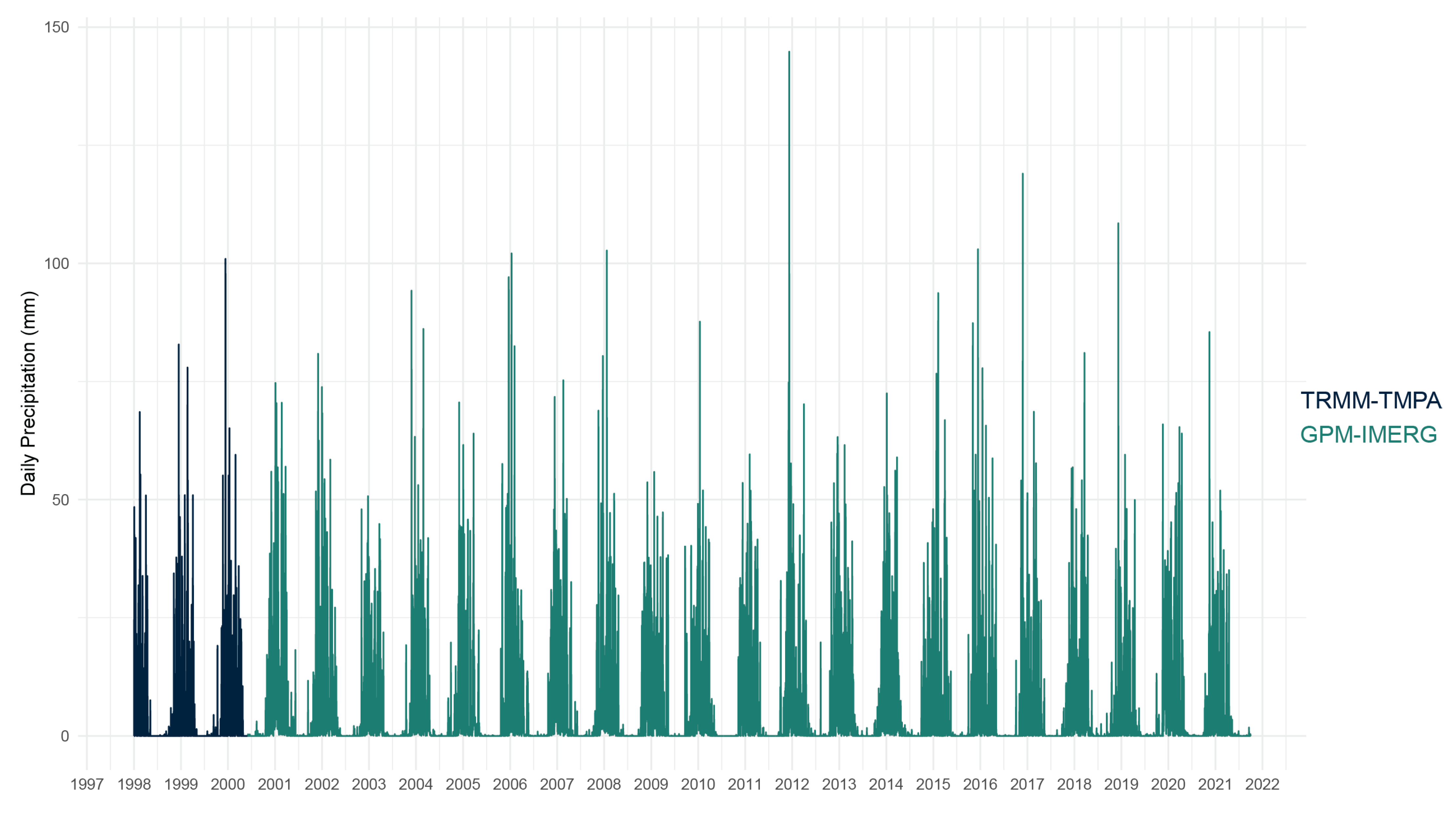
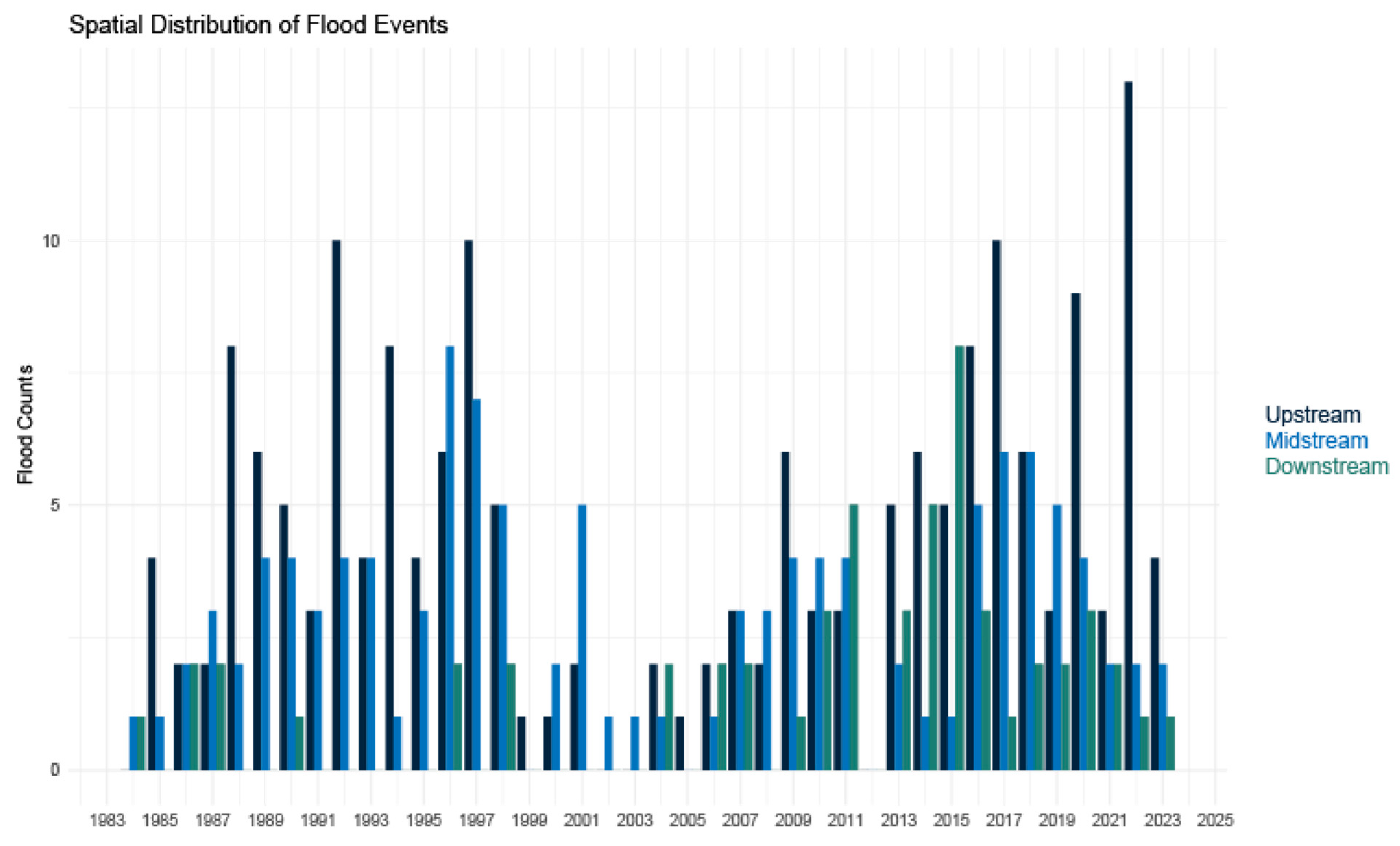
References
- Datry, T.; Larned, S.T.; Tockner, K. Intermittent Rivers: A Challenge for Freshwater Ecology. BioScience 2014, 64, 229–235. [Google Scholar] [CrossRef]
- Messager, M.L.; Lehner, B.; Cockburn, C.; Lamouroux, N.; Pella, H.; Snelder, T.; Tockner, K.; Trautmann, T.; Watt, C.; Datry, T. Global Prevalence of Non-Perennial Rivers and Streams. Nature 2021, 594, 391–397. [Google Scholar] [CrossRef] [PubMed]
- Costigan, K.H.; Kennard, M.J.; Leigh, C.; Sauquet, E.; Datry, T.; Boulton, A.J. Chapter 2.2—Flow Regimes in Intermittent Rivers and Ephemeral Streams. In Intermittent Rivers and Ephemeral Streams; Datry, T., Bonada, N., Boulton, A., Eds.; Academic Press: Cambridge, MA, USA, 2017; pp. 51–78. ISBN 978-0-12-803835-2. [Google Scholar]
- Hammond, J.C.; Zimmer, M.; Shanafield, M.; Kaiser, K.; Godsey, S.E.; Mims, M.C.; Zipper, S.C.; Burrows, R.M.; Kampf, S.K.; Dodds, W.; et al. Spatial Patterns and Drivers of Nonperennial Flow Regimes in the Contiguous United States. Geophys. Res. Lett. 2021, 48, e2020GL090794. [Google Scholar] [CrossRef]
- Zipper, S.C.; Hammond, J.C.; Shanafield, M.; Zimmer, M.; Datry, T.; Jones, C.N.; Kaiser, K.E.; Godsey, S.E.; Burrows, R.M.; Blaszczak, J.R.; et al. Pervasive Changes in Stream Intermittency across the United States. Environ. Res. Lett. 2021, 16, 084033. [Google Scholar] [CrossRef]
- Costigan, K.H.; Jaeger, K.L.; Goss, C.W.; Fritz, K.M.; Goebel, P.C. Understanding Controls on Flow Permanence in Intermittent Rivers to Aid Ecological Research: Integrating Meteorology, Geology and Land Cover: Integrating Science to Understand Flow Intermittence. Ecohydrology 2016, 9, 1141–1153. [Google Scholar] [CrossRef]
- Stubbington, R.; Acreman, M.; Acuña, V.; Boon, P.J.; Boulton, A.J.; England, J.; Gilvear, D.; Sykes, T.; Wood, P.J. Ecosystem Services of Temporary Streams Differ between Wet and Dry Phases in Regions with Contrasting Climates and Economies. People Nat. 2020, 2, 660–677. [Google Scholar] [CrossRef]
- Stark, K.; Cadol, D.; Varyu, D.; Laronne, J.B. Direct, Continuous Measurements of Ultra-High Sediment Fluxes in a Sandy Gravel-Bed Ephemeral River. Geomorphology 2021, 382, 107682. [Google Scholar] [CrossRef]
- Zimmer, M.A.; Burgin, A.J.; Kaiser, K.; Hosen, J. The Unknown Biogeochemical Impacts of Drying Rivers and Streams. Nat. Commun. 2022, 13, 7213. [Google Scholar] [CrossRef]
- Zimmer, M.A.; Kaiser, K.E.; Blaszczak, J.R.; Zipper, S.C.; Hammond, J.C.; Fritz, K.M.; Costigan, K.H.; Hosen, J.; Godsey, S.E.; Allen, G.H.; et al. Zero or Not? Causes and Consequences of Zero-flow Stream Gage Readings. WIREs Water 2020, 7, e1436. [Google Scholar] [CrossRef]
- Milewski, A.; Sultan, M.; Yan, E.; Becker, R.; Abdeldayem, A.; Soliman, F.; Gelil, K.A. A Remote Sensing Solution for Estimating Runoff and Recharge in Arid Environments. J. Hydrol. 2009, 373, 1–14. [Google Scholar] [CrossRef]
- Milewski, A.; Elkadiri, R.; Durham, M. Assessment and Comparison of TMPA Satellite Precipitation Products in Varying Climatic and Topographic Regimes in Morocco. Remote Sens. 2015, 7, 5697–5717. [Google Scholar] [CrossRef]
- Fakir, Y.; Bouimouass, H.; Constantz, J. Seasonality in Intermittent Streamflow Losses Beneath a Semiarid Mediterranean Wadi. Water Resour. Res. 2021, 57, e2021WR029743. [Google Scholar] [CrossRef]
- Shentsis, I.; Rosenthal, E. Recharge of Aquifers by Flood Events in an Arid Region. Hydrol. Process. 2003, 17, 695–712. [Google Scholar] [CrossRef]
- Shanafield, M.; Cook, P.G. Transmission Losses, Infiltration and Groundwater Recharge through Ephemeral and Intermittent Streambeds: A Review of Applied Methods. J. Hydrol. 2014, 511, 518–529. [Google Scholar] [CrossRef]
- Levick, L.R.; Goodrich, D.C.; Hernandez, M.; Fonseca, J.; Semmens, D.J.; Stromberg, J.C.; Tluczek, M.; Leidy, R.A.; Scianni, M.; Guertin, D.P.; et al. The Ecological and Hydrological Significance of Ephemeral and Intermittent Streams in the Arid and Semi-Arid American Southwest; US Environmental Protection Agency, Office of Research and Development: Washington, DC, USA, 2008.
- Costa, A.C.; Foerster, S.; de Araújo, J.C.; Bronstert, A. Analysis of Channel Transmission Losses in a Dryland River Reach in North-Eastern Brazil Using Streamflow Series, Groundwater Level Series and Multi-Temporal Satellite Data. Hydrol. Process. 2013, 27, 1046–1060. [Google Scholar] [CrossRef]
- Krabbenhoft, C.A.; Allen, G.H.; Lin, P.; Godsey, S.E.; Allen, D.C.; Burrows, R.M.; DelVecchia, A.G.; Fritz, K.M.; Shanafield, M.; Burgin, A.J.; et al. Assessing Placement Bias of the Global River Gauge Network. Nat. Sustain. 2022, 5, 586–592. [Google Scholar] [CrossRef] [PubMed]
- Döll, P.; Schmied, H.M. How Is the Impact of Climate Change on River Flow Regimes Related to the Impact on Mean Annual Runoff? A Global-Scale Analysis. Environ. Res. Lett. 2012, 7, 014037. [Google Scholar] [CrossRef]
- Alsdorf, D.E.; Rodríguez, E.; Lettenmaier, D.P. Measuring Surface Water from Space. Rev. Geophys. 2007, 45, 2002. [Google Scholar] [CrossRef]
- Zhou, Y.; Dong, J.; Xiao, X.; Xiao, T.; Yang, Z.; Zhao, G.; Zou, Z.; Qin, Y. Open Surface Water Mapping Algorithms: A Comparison of Water-Related Spectral Indices and Sensors. Water 2017, 9, 256. [Google Scholar] [CrossRef]
- McFEETERS, S.K. The Use of the Normalized Difference Water Index (NDWI) in the Delineation of Open Water Features. Int. J. Remote Sens. 1996, 17, 1425–1432. [Google Scholar] [CrossRef]
- Xu, H. Modification of Normalised Difference Water Index (NDWI) to Enhance Open Water Features in Remotely Sensed Imagery. Int. J. Remote Sens. 2006, 27, 3025–3033. [Google Scholar] [CrossRef]
- Feyisa, G.L.; Meilby, H.; Fensholt, R.; Proud, S.R. Automated Water Extraction Index: A New Technique for Surface Water Mapping Using Landsat Imagery. Remote Sens. Environ. 2014, 140, 23–35. [Google Scholar] [CrossRef]
- Fisher, A.; Flood, N.; Danaher, T. Comparing Landsat Water Index Methods for Automated Water Classification in Eastern Australia. Remote Sens. Environ. 2016, 175, 167–182. [Google Scholar] [CrossRef]
- Seaton, D.; Mazvimavi, D. Use of Multi-Temporal Satellite Data for Monitoring Pool Surface Areas Occurring in Non-Perennial Rivers in Semi-Arid Environments of the Western Cape, South Africa. ISPRS J. Photogramm. Remote Sens. 2020, 167, 375–384. [Google Scholar] [CrossRef]
- Maswanganye, S.E. Remotely Sensed Applications in Monitoring the Spatio-Temporal Dynamics of Pools and Flows along Non-Perennial Rivers: A Review|South African Geographical Journal = Suid-Afrikaanse Geografiese Tydskrif. Available online: https://journals.co.za/doi/abs/10.1080/03736245.2021.1967774 (accessed on 10 August 2023).
- Tulbure, M.G.; Broich, M.; Stehman, S.V.; Kommareddy, A. Surface Water Extent Dynamics from Three Decades of Seasonally Continuous Landsat Time Series at Subcontinental Scale in a Semi-Arid Region. Remote Sens. Environ. 2016, 178, 142–157. [Google Scholar] [CrossRef]
- Borg Galea, A.; Sadler, J.P.; Hannah, D.M.; Datry, T.; Dugdale, S.J. Mediterranean Intermittent Rivers and Ephemeral Streams: Challenges in Monitoring Complexity. Ecohydrology 2019, 12, e2149. [Google Scholar] [CrossRef]
- Sun, F.; Sun, W.; Chen, J.; Gong, P. Comparison and Improvement of Methods for Identifying Waterbodies in Remotely Sensed Imagery. Int. J. Remote Sens. 2012, 33, 6854–6875. [Google Scholar] [CrossRef]
- Hamada, Y.; O’Connor, B.L.; Orr, A.B.; Wuthrich, K.K. Mapping Ephemeral Stream Networks in Desert Environments Using Very-High-Spatial-Resolution Multispectral Remote Sensing. J. Arid Environ. 2016, 130, 40–48. [Google Scholar] [CrossRef]
- Jacobberger, P.A.; Arvidson, R.E.; Rashka, D.L. Application of Landsat Multispectral Scanner Data and Sediment Spectral Reflectance Measurements to Mapping of the Meatiq Dome, Egypt. Geology 1983, 11, 587–591. [Google Scholar] [CrossRef]
- Isikdogan, F.; Bovik, A.C.; Passalacqua, P. Surface Water Mapping by Deep Learning. IEEE J. Sel. Top. Appl. Earth Obs. Remote Sens. 2017, 10, 4909–4918. [Google Scholar] [CrossRef]
- Fei, J.; Liu, J.; Ke, L.; Wang, W.; Wu, P.; Zhou, Y. A Deep Learning-Based Method for Mapping Alpine Intermittent Rivers and Ephemeral Streams of the Tibetan Plateau from Sentinel-1 Time Series and DEMs. Remote Sens. Environ. 2022, 282, 113271. [Google Scholar] [CrossRef]
- Malinowski, R.; Höfle, B.; Koenig, K.; Groom, G.; Schwanghart, W.; Heckrath, G. Local-Scale Flood Mapping on Vegetated Floodplains from Radiometrically Calibrated Airborne LiDAR Data. ISPRS J. Photogramm. Remote Sens. 2016, 119, 267–279. [Google Scholar] [CrossRef]
- Veh, G.; Korup, O.; Roessner, S.; Walz, A. Detecting Himalayan Glacial Lake Outburst Floods from Landsat Time Series. Remote Sens. Environ. 2018, 207, 84–97. [Google Scholar] [CrossRef]
- Chen, H.; Liang, Q.; Liang, Z.; Liu, Y.; Ren, T. Extraction of Connected River Networks from Multi-Temporal Remote Sensing Imagery Using a Path Tracking Technique. Remote Sens. Environ. 2020, 246, 111868. [Google Scholar] [CrossRef]
- World Meteorological Organization (WMO). Guidelines on the Calculation of Climate Normals; WMO: Geneva, Switzerland, 2017. [Google Scholar]
- Bouchaou, L.; Tagma, T.; Boutaleb, S.; Hssaisoune, M.; El Morjani, Z.E.A. Climate Change and Its Impacts on Groundwater Resources in Morocco: The Case of the Souss-Massa Basin. In Climate Change Effects on Groundwater Resources: A Global Synthesis of Findings and Recommendations; Taylor & Francis Group: London, UK, 2011; pp. 129–144. [Google Scholar]
- Hssaisoune, M.; Boutaleb, S.; Benssaou, M.; Bouaakkaz, B. Physical Geography, Geology, and Water Resource Availability of the Souss-Massa River Basin; Springer: Berlin/Heidelberg, Germany, 2016. [Google Scholar]
- Hssaisoune, M.; Bouchaou, L.; Matsumoto, T.; Araguas, L.; Kraml, M.; Aggarwal, P. New Evidences on Groundwater Dynamics from the Souss-Massa System (Morocco): Insights Gained from Dissolved Noble Gases. Appl. Geochem. 2019, 109, 104395. [Google Scholar] [CrossRef]
- Choukr-Allah, R.; Ragab, R.; Bouchaou, L.; Barcelo, D. The Souss-Massa River Basin, Morocco; Springer: Berlin, Germany, 2016; ISBN 978-3-319-51129-0. [Google Scholar]
- Ait Brahim, Y.; Seif-Ennasr, M.; Malki, M.; N’da, B.; Choukrallah, R.; El Morjani, Z.E.A.; Sifeddine, A.; Abahous, H.; Bouchaou, L. Assessment of Climate and Land Use Changes: Impacts on Groundwater Resources in the Souss-Massa River Basin. In The Souss-Massa River Basin, Morocco; Choukr-Allah, R., Ragab, R., Bouchaou, L., Barceló, D., Eds.; The Handbook of Environmental Chemistry; Springer International Publishing: Cham, Switzerland, 2017; pp. 121–142. ISBN 978-3-319-51131-3. [Google Scholar]
- Dindane, K.; Bouchaou, L.; Hsissou, Y.; Krimissa, M. Hydrochemical and Isotopic Characteristics of Groundwater in the Souss Upstream Basin, Southwestern Morocco. J. Afr. Earth Sci. 2003, 36, 315–327. [Google Scholar] [CrossRef]
- Bouragba, L.; Mudry, J.; Bouchaou, L.; Hsissou, Y.; Krimissa, M.; Tagma, T.; Michelot, J.L. Isotopes and Groundwater Management Strategies under Semi-Arid Area: Case of the Souss Upstream Basin (Morocco). Appl. Radiat. Isot. 2011, 69, 1084–1093. [Google Scholar] [CrossRef]
- Bouizrou, I.; Bouadila, A.; Aqnouy, M.; Gourfi, A. Assessment of Remotely Sensed Precipitation Products for Climatic and Hydrological Studies in Arid to Semi-Arid Data-Scarce Region, Central-Western Morocco. Remote Sens. Appl. Soc. Environ. 2023, 30, 100976. [Google Scholar] [CrossRef]
- Almulla, Y.; Ramirez, C.; Joyce, B.; Huber-Lee, A.; Fuso-Nerini, F. From Participatory Process to Robust Decision-Making: An Agriculture-Water-Energy Nexus Analysis for the Souss-Massa Basin in Morocco. Energy Sustain. Dev. 2022, 70, 314–338. [Google Scholar] [CrossRef]
- Chavez, P.S. An Improved Dark-Object Subtraction Technique for Atmospheric Scattering Correction of Multispectral Data. Remote Sens. Environ. 1988, 24, 459–479. [Google Scholar] [CrossRef]
- Davis, J.C. Statistics and Data Analysis in Geology, 3rd ed.; Wiley: New York, NY, USA, 2002; ISBN 0-47 1-1 7275-8. [Google Scholar]
- Maindonald, J.; Braun, W.J. Data Analysis and Graphics Using R—An Example-Based Approach, 3rd ed.; University Press: Cambridge, UK, 2003; ISBN 13 978-0-511-71286-9. [Google Scholar]
- R Core Team. R: A Language and Environment for Statistical Computing; R Foundation for Statistical Computing: Vienna, Austria, 2011. [Google Scholar]
- Venables, W.N.; Ripley, B.D. Modern Applied Statistics with S, 4th ed.; Springer: New York, NY, USA, 2002; ISBN 0-387-95457-0. [Google Scholar]
- Andrefouet, S.; Bindschadler, R.; Brown de Colstoun, E.; Choate, M. Preliminary Assessment of the Value of Landsat-7 ETM+ Data Following Scan Line Corrector Malfunction; US Geological Survey, EROS Data Center: Sioux Falls, SD, USA, 2003. [Google Scholar]
- Tian, Y.; Peters-Lidard, C.D.; Eylander, J.B.; Joyce, R.J.; Huffman, G.J.; Adler, R.F.; Hsu, K.; Turk, F.J.; Garcia, M.; Zeng, J. Component Analysis of Errors in Satellite-Based Precipitation Estimates. J. Geophys. Res. Atmos. 2009, 114, D24101. [Google Scholar] [CrossRef]
- Tramblay, Y.; Thiemig, V.; Dezetter, A.; Hanich, L. Evaluation of Satellite-Based Rainfall Products for Hydrological Modelling in Morocco. Hydrol. Sci. J. 2016, 61, 2509–2519. [Google Scholar] [CrossRef]
- Saouabe, T.; El Khalki, E.M.; Saidi, M.E.M.; Najmi, A.; Hadri, A.; Rachidi, S.; Jadoud, M.; Tramblay, Y. Evaluation of the GPM-IMERG Precipitation Product for Flood Modeling in a Semi-Arid Mountainous Basin in Morocco. Water 2020, 12, 2516. [Google Scholar] [CrossRef]
- Tang, G.; Clark, M.P.; Papalexiou, S.M.; Ma, Z.; Hong, Y. Have Satellite Precipitation Products Improved over Last Two Decades? A Comprehensive Comparison of GPM IMERG with Nine Satellite and Reanalysis Datasets. Remote Sens. Environ. 2020, 240, 111697. [Google Scholar] [CrossRef]
- Shawky, M.; Moussa, A.; Hassan, Q.K.; El-Sheimy, N. Performance Assessment of Sub-Daily and Daily Precipitation Estimates Derived from GPM and GSMaP Products over an Arid Environment. Remote Sens. 2019, 11, 2840. [Google Scholar] [CrossRef]
- Verner, D.; Treguer, D.; Redwood, J.; Christensen, J.; McDonnell, R.; Elbert, C.; Konishi, Y.; Belghazi, S. Climate Variability, Drought, and Drought Management in Morocco’s Agricultural Sector; World Bank: Washington, DC, USA, 2018. [Google Scholar]
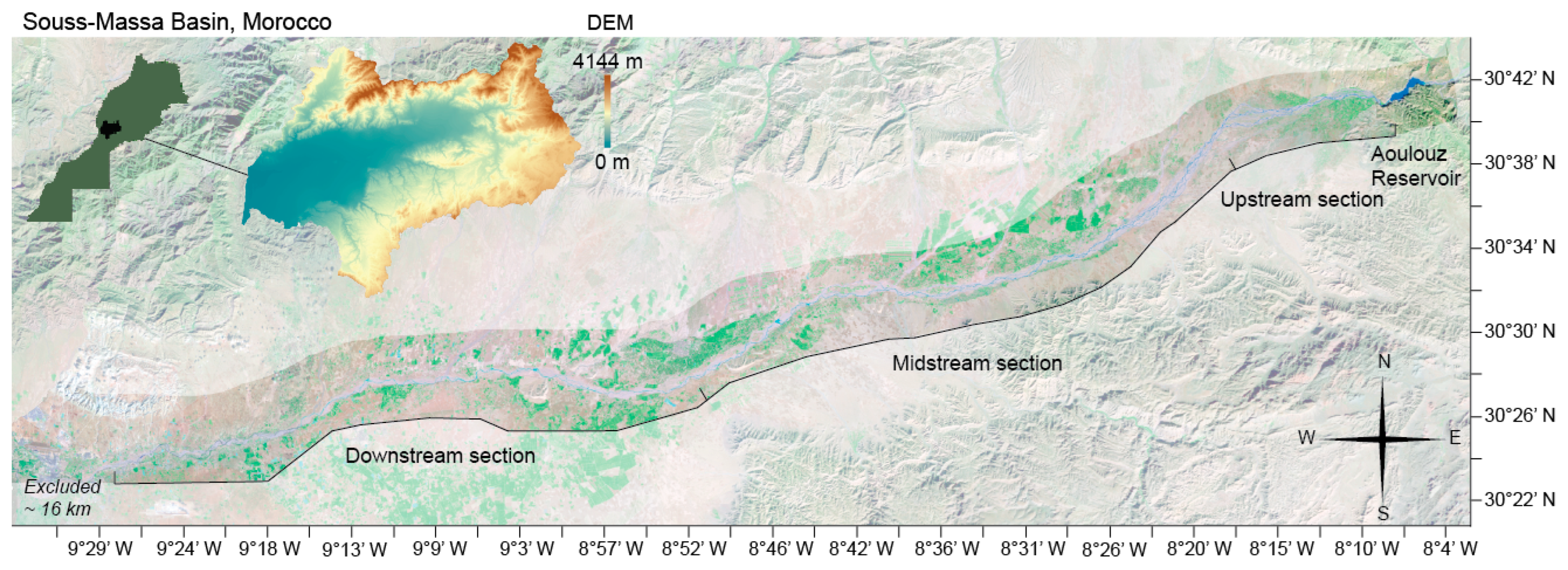
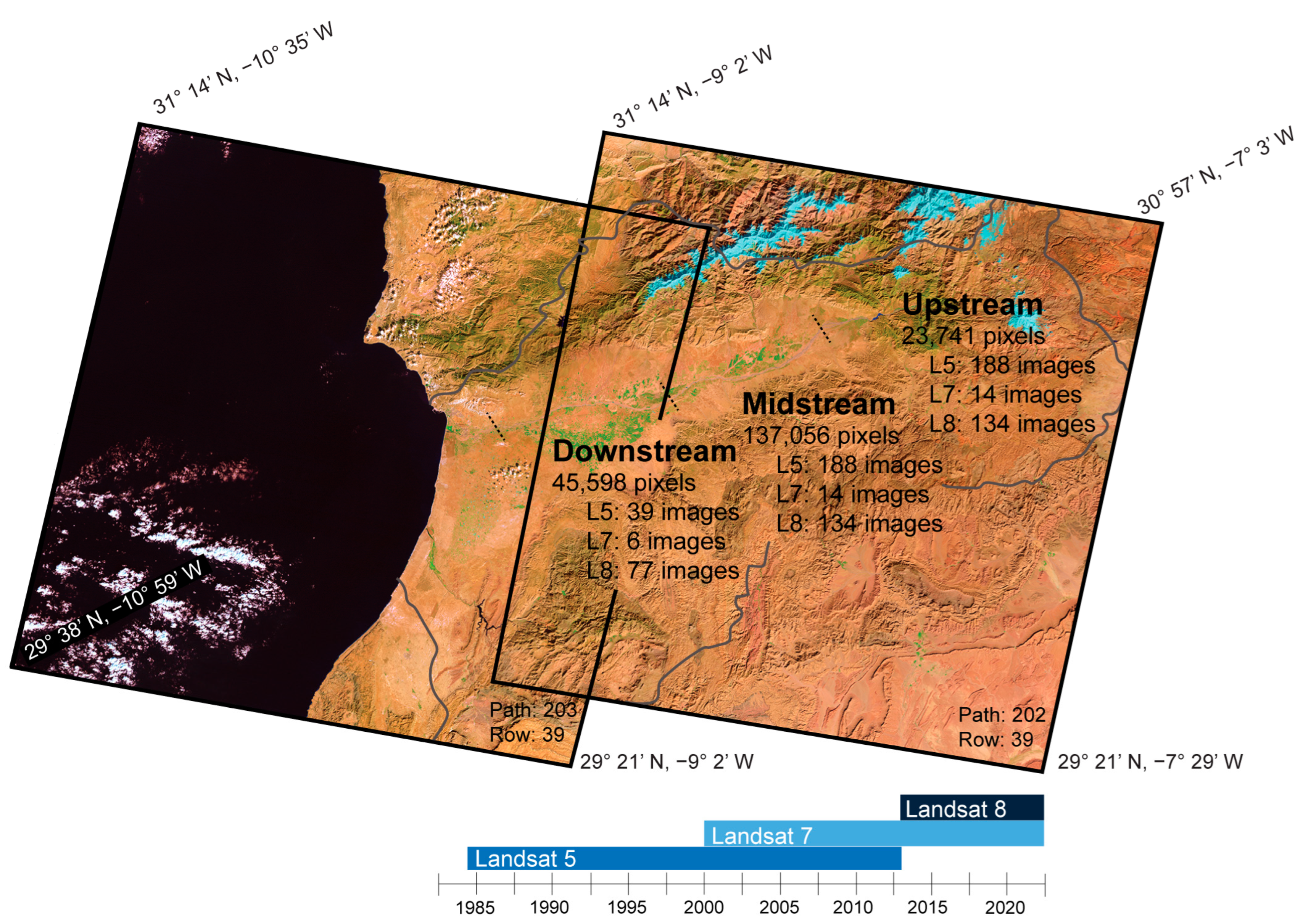
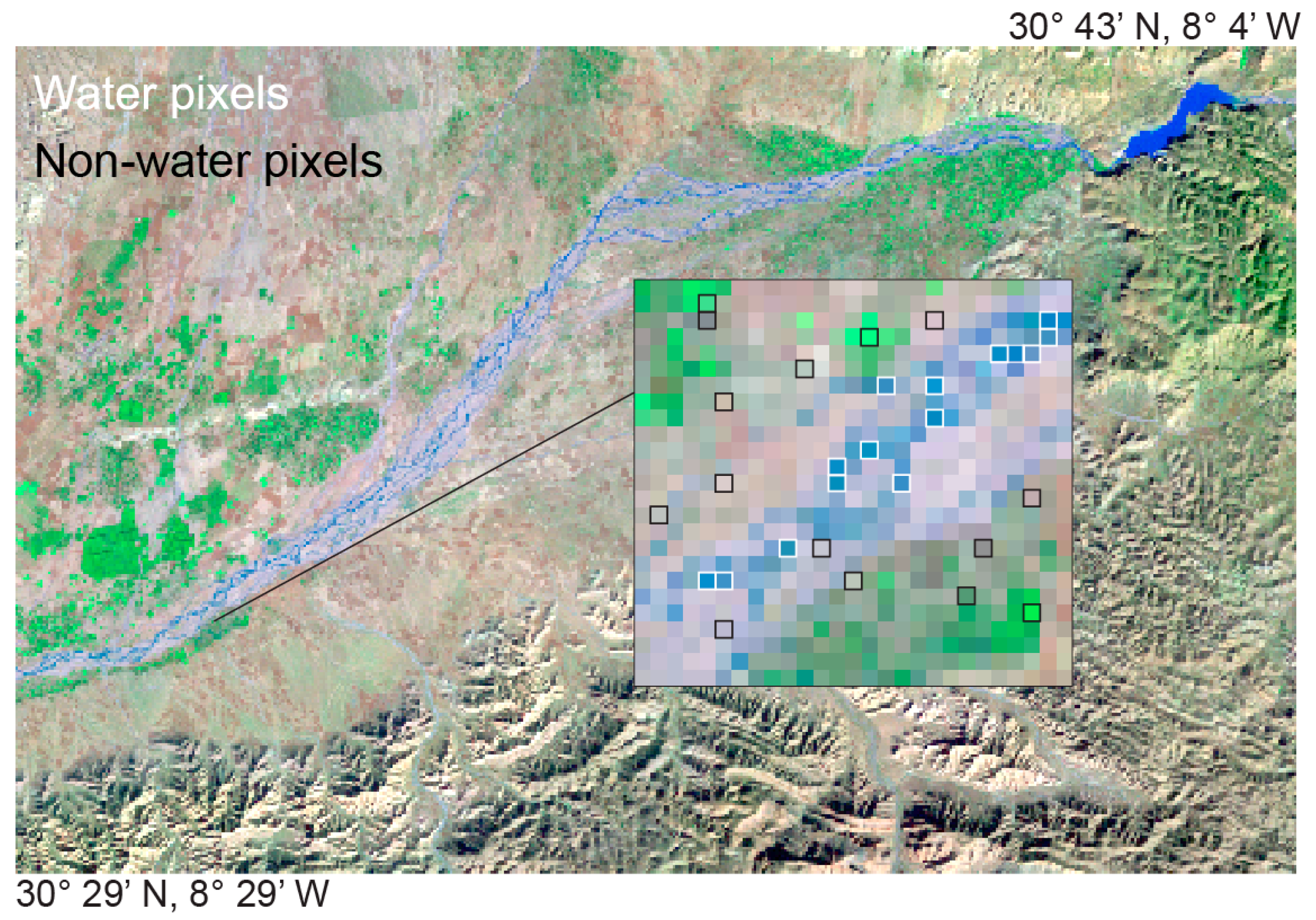
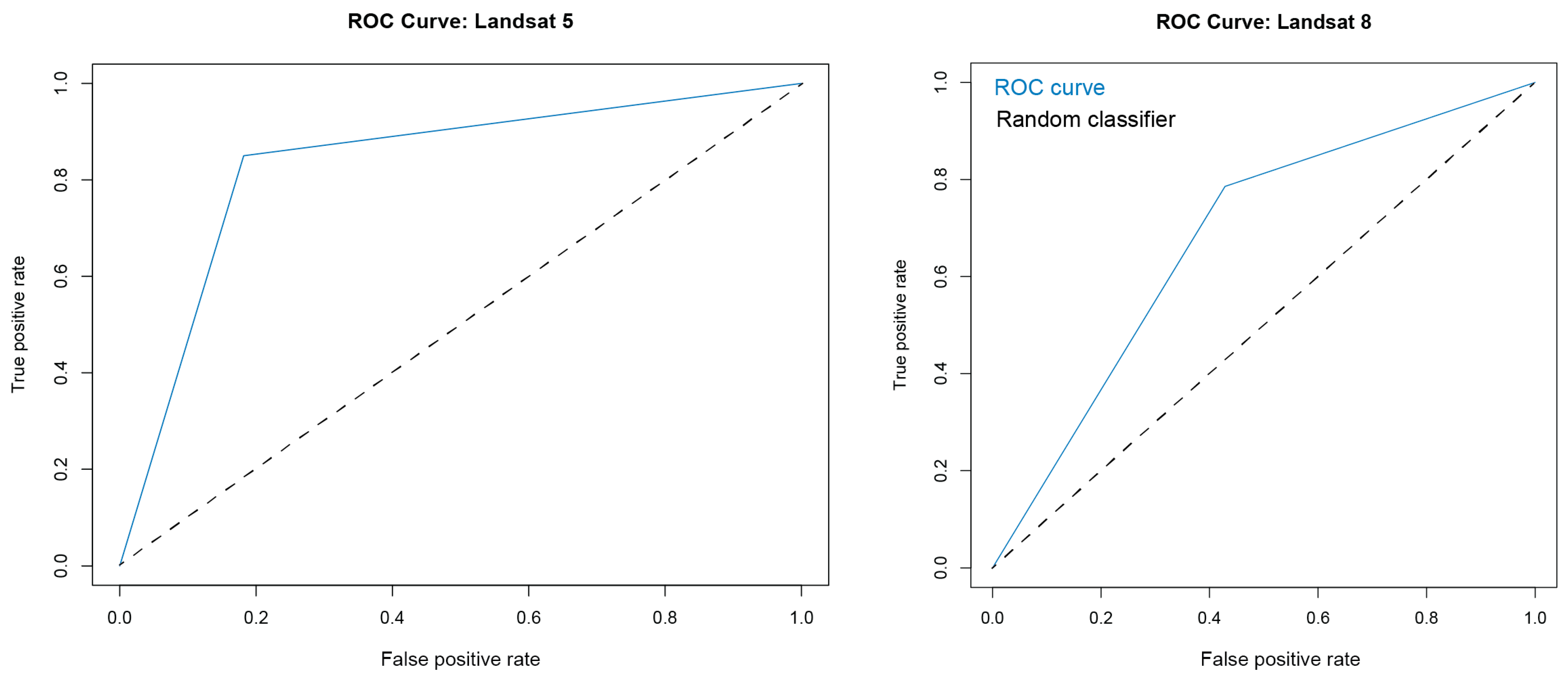

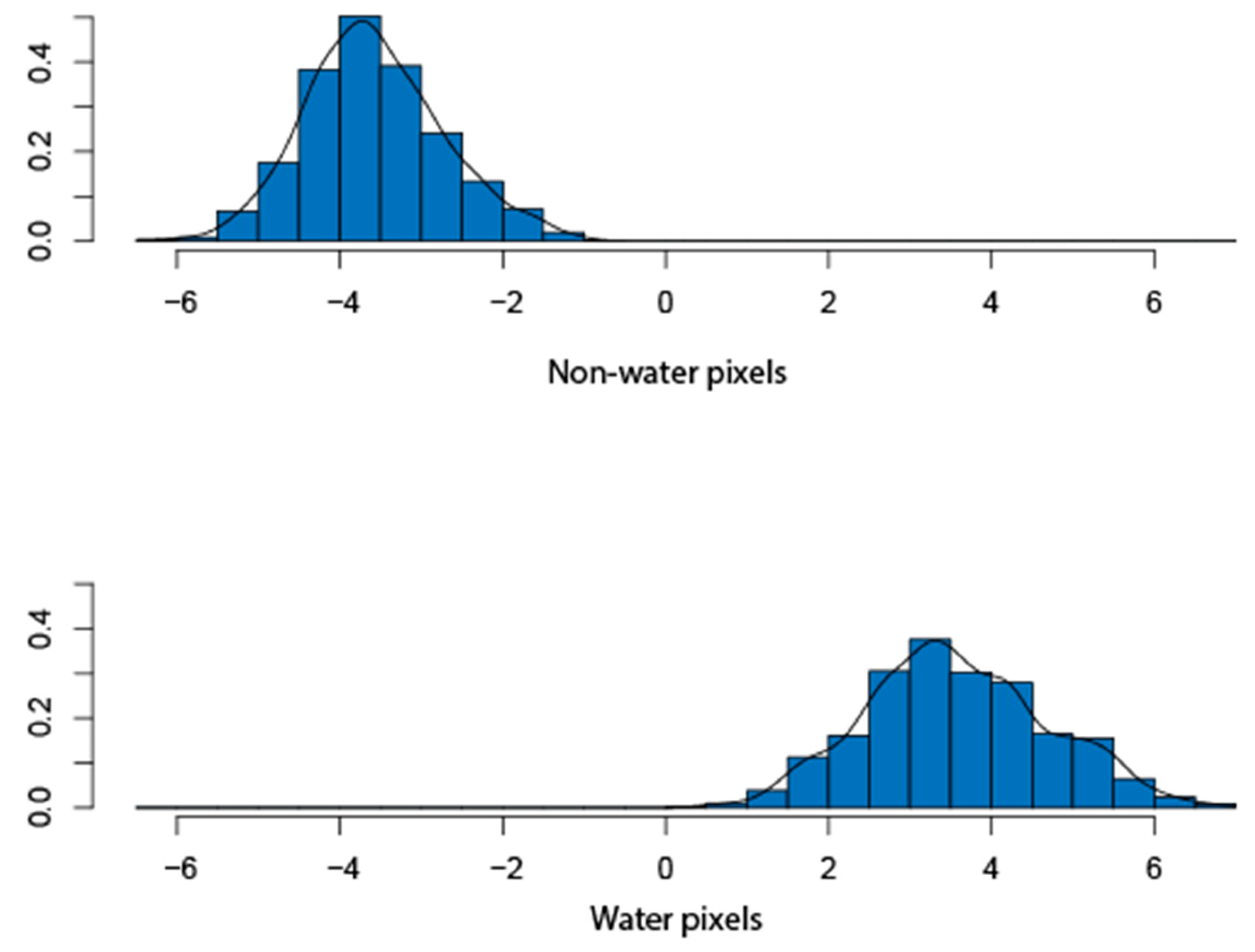
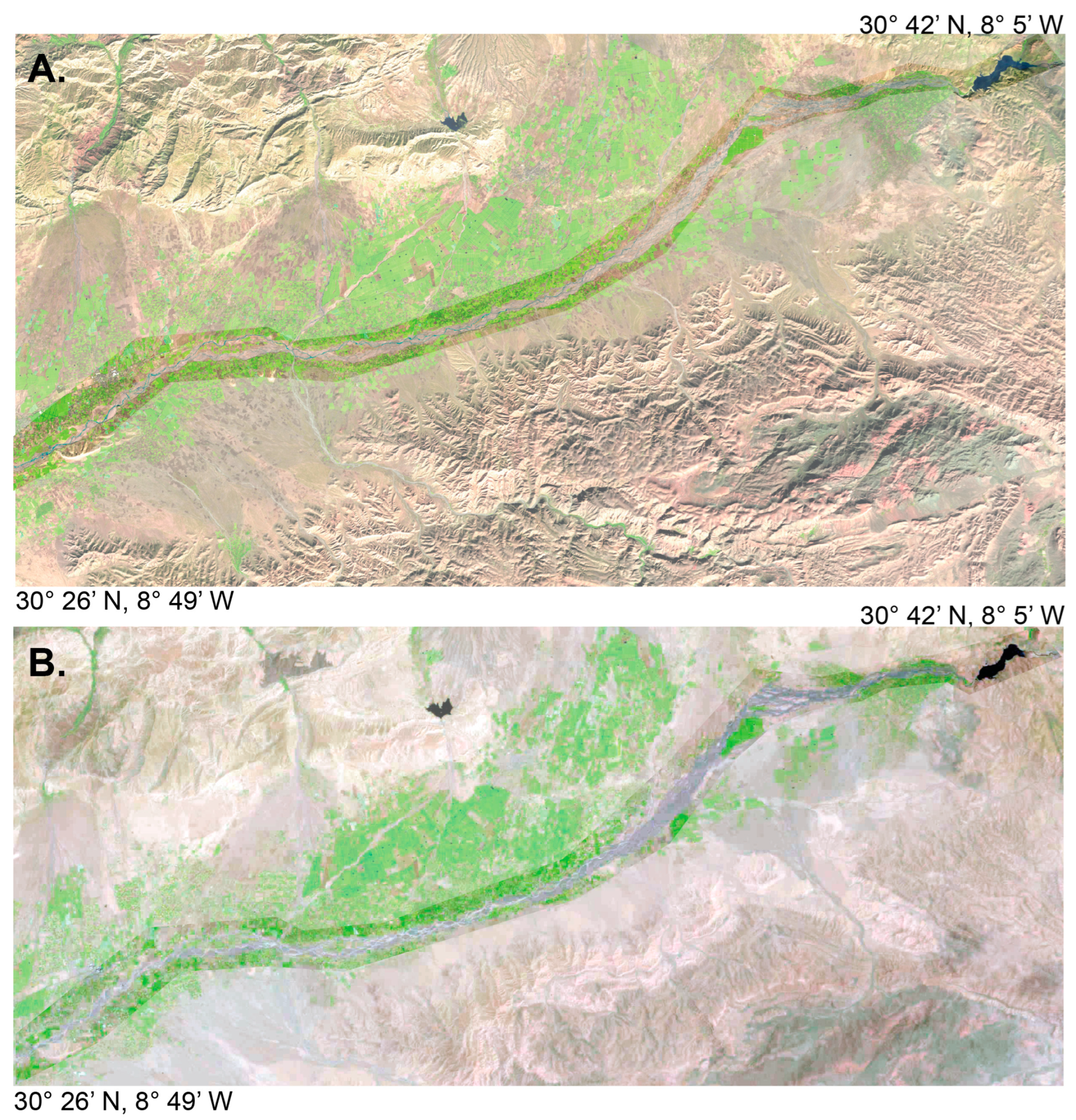
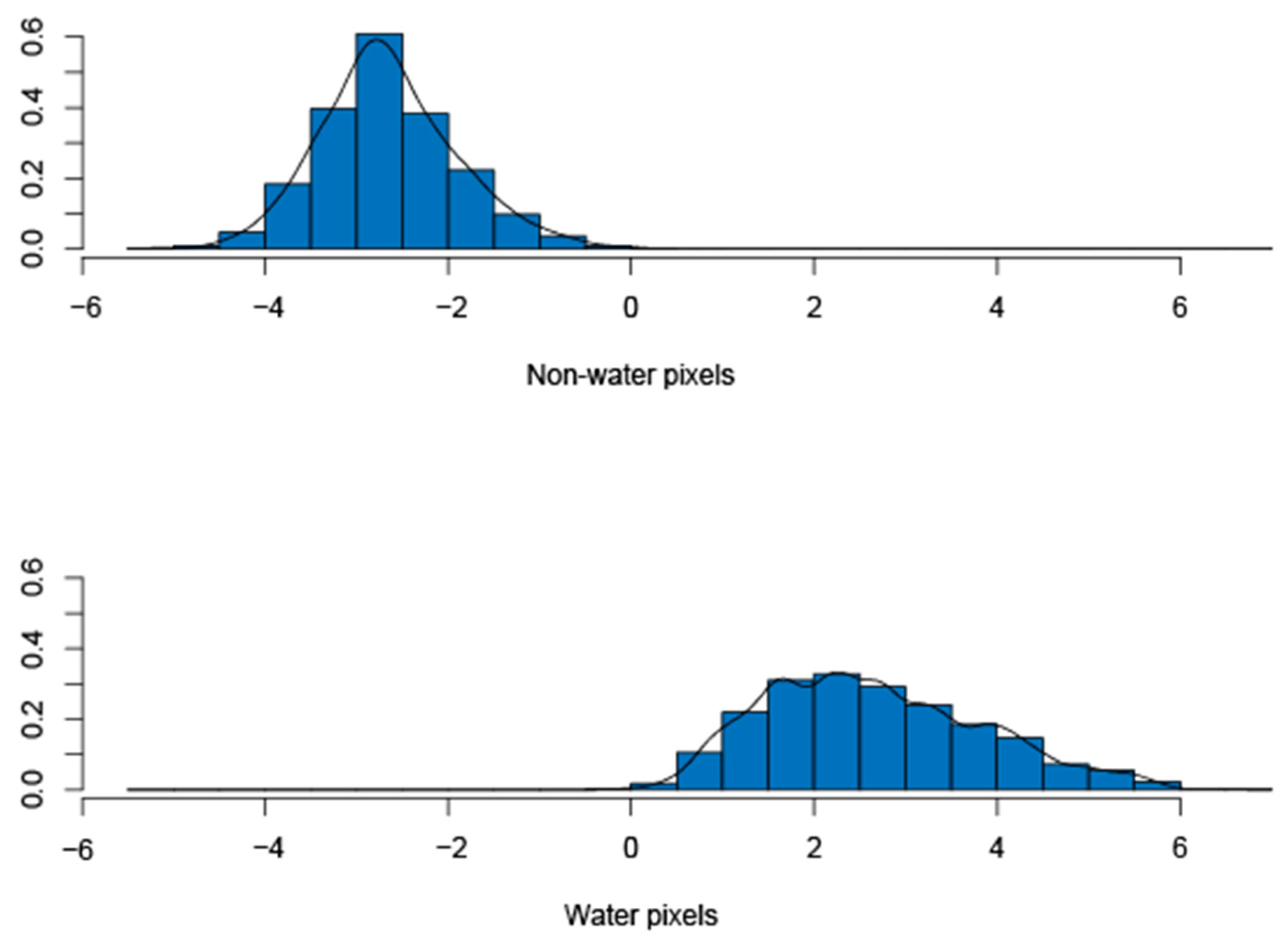
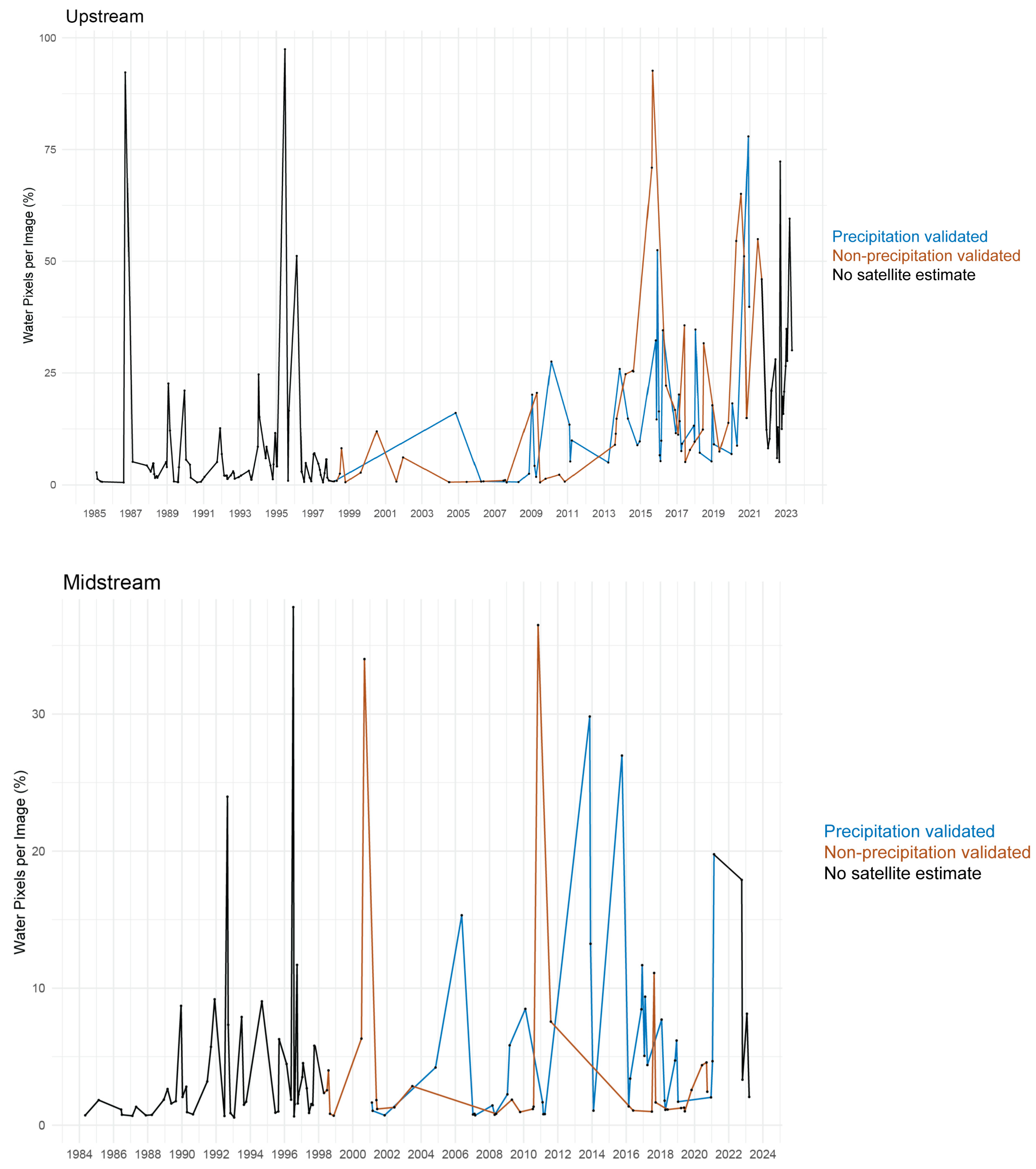
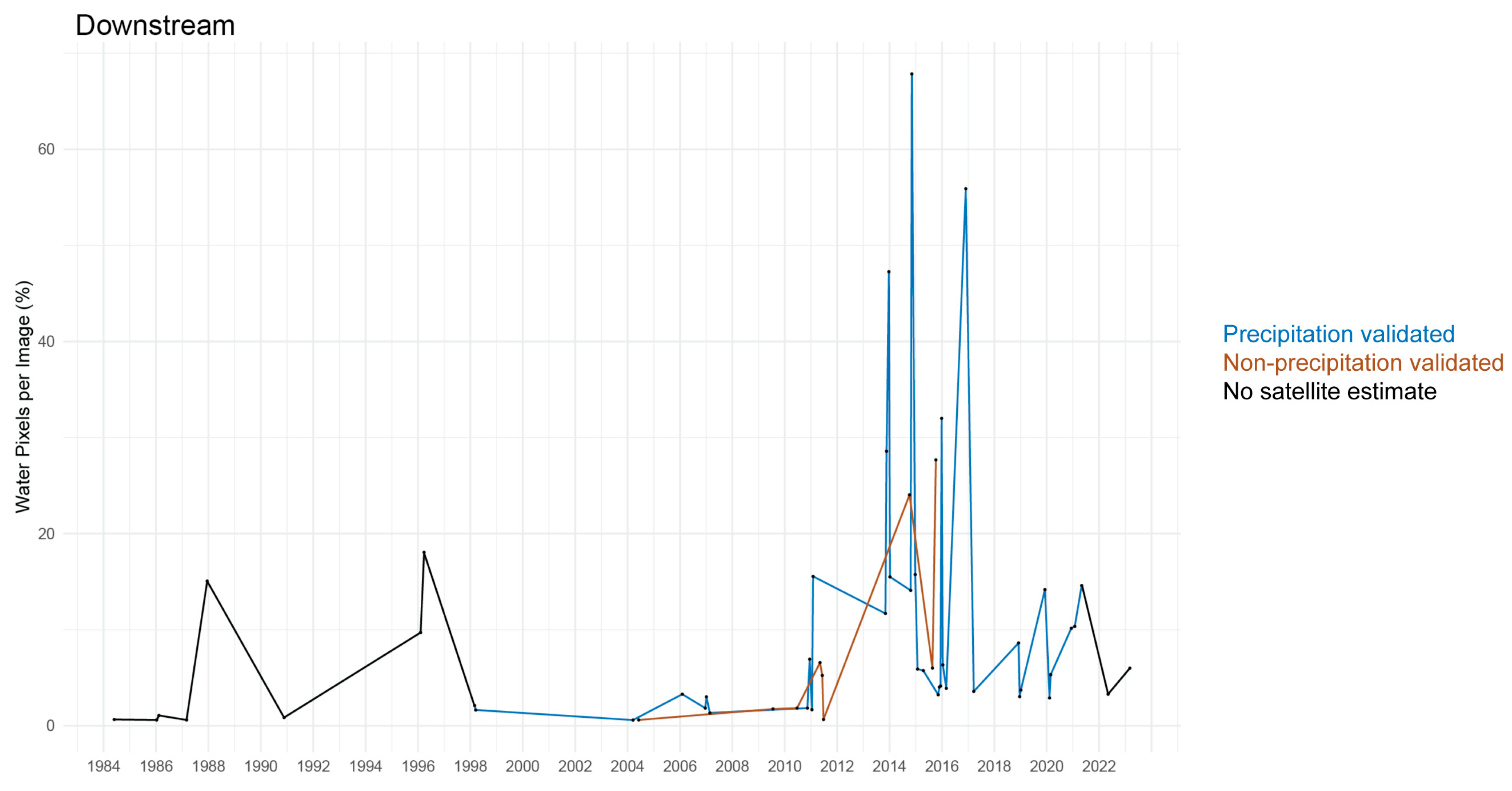
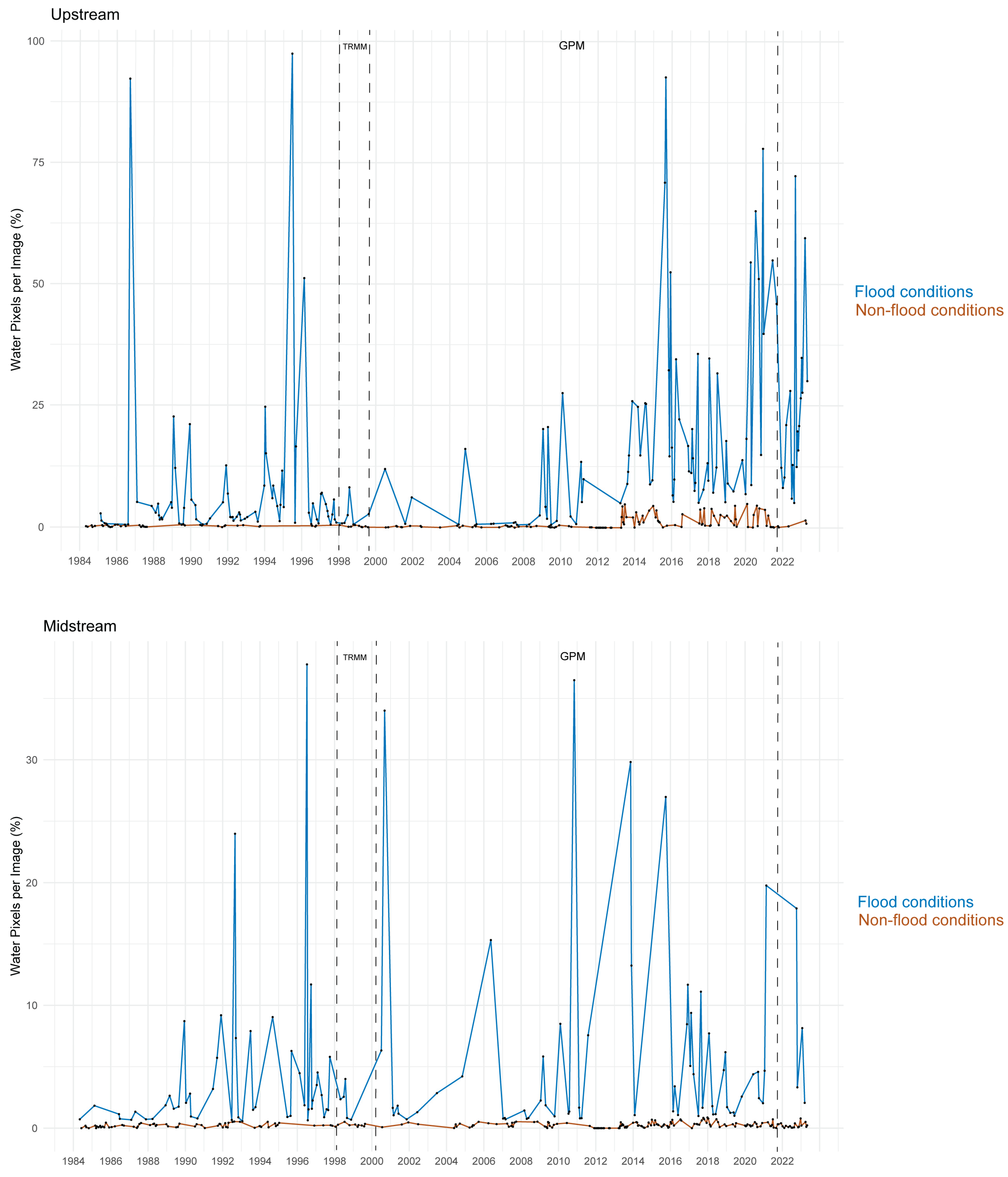


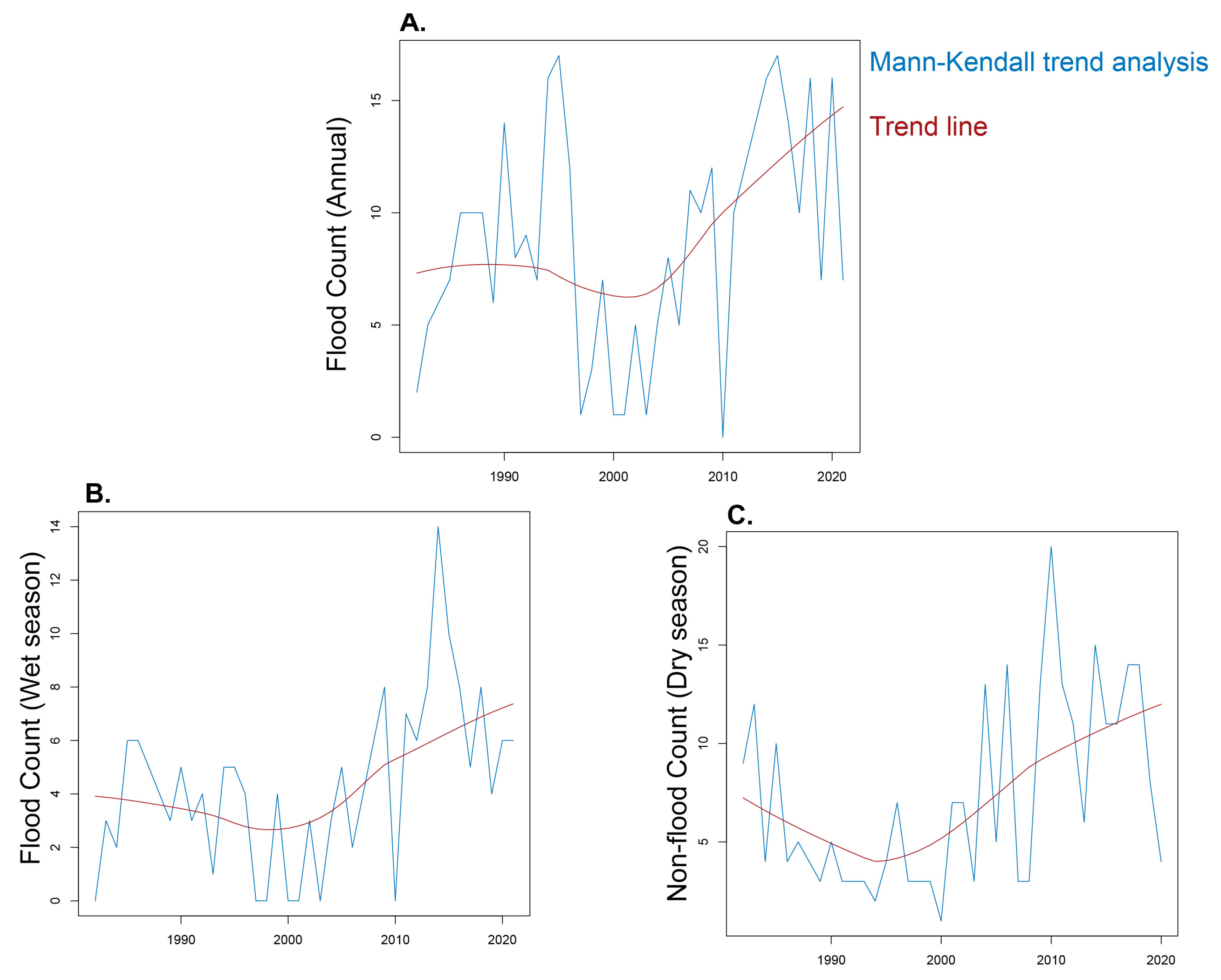
| Satellite | Filtered Temporal Range | Bands | Range | Resolution |
|---|---|---|---|---|
| Landsat 5 TM TOA Collection 1, Tier 1 | May 1984–September 2011 | Band 1: Blue | 30 m | 0.45–0.52 μm |
| Band 2: Green | 30 m | 0.52–0.60 μm | ||
| Band 3: Red | 30 m | 0.63–0.69 μm | ||
| Band 4: NIR | 30 m | 0.76–0.90 μm | ||
| Band 5: SWIR 1 | 30 m | 1.55–1.75 μm | ||
| Band 6: Thermal Infrared | 60 m | 10.40–12.50 μm | ||
| Band 7: SWIR 2 | 30 m | 2.08–2.35 μm | ||
| Landsat 7 TOA Collection 1, Tier 1 | October 2011–April 2013 | Band 1: Blue | 30 m | 0.45–0.52 μm |
| Band 2: Green | 30 m | 0.52–0.60 μm | ||
| Band 3: Red | 30 m | 0.63–0.69 μm | ||
| Band 4: NIR | 30 m | 0.77–0.90 μm | ||
| Band 5: SWIR 1 | 30 m | 1.55–1.75 μm | ||
| Band 6: Thermal Infrared | 60 m | 10.40–12.50 μm | ||
| Band 7: SWIR 2 | 30 m | 2.08–2.35 μm | ||
| Band 8: Panchromatic | 15 m | 0.52–0.90 μm | ||
| Landsat 8 TOA Collection 2, Tier 1 | April 2013–May 2023 | Band 1: Coastal aerosol | 30 m | 0.43–0.45 μm |
| Band 2: Blue | 30 m | 0.45–0.51 μm | ||
| Band 3: Green | 30 m | 0.53–0.59 μm | ||
| Band 4: Red | 30 m | 0.64–0.67 μm | ||
| Band 5: NIR | 30 m | 0.85–0.88 μm | ||
| Band 6: SWIR 1 | 30 m | 1.57–1.65 μm | ||
| Band 7: SWIR 2 | 30 m | 2.11–2.29 μm | ||
| Band 8: Panchromatic | 15 m | 0.52–0.90 μm | ||
| Band 9: Cirrus | 30 m | 1.36–1.38 μm | ||
| Band 10: Thermal Infrared 1 | 100 m | 10.60–11.19 μm | ||
| Band 11: Thermal Infrared 2 | 100 m | 11.50–12.51 μm |
| Landsat 5 LDA | Training Pixels | Predictive Accuracy | Jackknife Predictive Accuracy | |
|---|---|---|---|---|
| Training Dataset Flood Image 30 September 1997 | Water pixels | 1600 | 100% | 100% |
| Non-water pixels | 1600 | 100% | 100% | |
| Test Classification | Pixels per Image | Predicted Water pixels | Predicted Non-water pixels | |
| Flood Image Midstream 30 September 1997 | 137,056 pixels | 7956 pixels (5.80%) | 129,100 pixels (94.20%) | |
| Non-flood Image Midstream 17 November 1997 | 137,056 pixels | 271 pixels (0.20%) | 136,785 pixels (99.80%) | |
| Bands | Loadings |
|---|---|
| Blue | −2.64 |
| Green | 3.38 |
| Red | 10.28 |
| NIR | −4.44 |
| SWIR 1 | −5.32 |
| SWIR 2 | −9.61 |
| Landsat 8 LDA | Training Pixels | Predictive Accuracy | Jackknife Predictive Accuracy | |
|---|---|---|---|---|
| Training Dataset Flood Image: 12 July 2016 | Water pixels | 1600 | 98.13% | 98.13% |
| Non-water pixels | 1600 | 98.75% | 98.69% | |
| Test Classification | Pixels per Image | Predicted Water pixels | Predicted Non-water pixels | |
| Flood Image Midstream, 12 July 2016 | 137,056 pixels | 16,014 pixels (11.68%) | 88.32% | |
| Non-flood Image Midstream, 16 July 2016 | 137,056 pixels | 970 pixels (0.71%) | 99.29% | |
| Bands | Loadings |
| Coastal aerosol | 38.19 |
| Blue | −44.28 |
| Green | 8.01 |
| Red | −2.25 |
| NIR | 7.25 |
| SWIR 1 | −10.63 |
| SWIR 2 | 11.37 |
| Cirrus | −1.76 |
| Modified NDWI | LDA | ||||
|---|---|---|---|---|---|
| Water Pixels | Non-Water Pixels | Water Pixels | Non-Water Pixels | ||
| Landsat 5 | Training dataset, Water pixels 30 September 1997 | 1450 | 150 | 1600 | 0 |
| Training dataset, Non-water pixels 30 September 1997 | 0 | 1600 | 0 | 1600 | |
| Flood Image, 30 September 1997 | 2647 (1.93%) | 134,409 (98.07%) | 7956 (5.80%) | 129,100 (94.20%) | |
| Non-flood Image, 17 November 1997 | 3 (0.002%) | 137,053 (99.99%) | 271 (0.20%) | 136,785 (99.80%) | |
| Landsat 8 | Training Dataset, Water pixels 12 July 2016 | 31 | 1569 | 1570 | 30 |
| Training Dataset, Non-water pixels 12 July 2016 | 1 | 1599 | 20 | 1580 | |
| Flood Image, 12 July 2016 | 90 (0.07%) | 136,966 (99.93%) | 16,014 (11.68%) | 121,042 (88.32%) | |
| Non-flood Image, 16 July 2016 | 0 (0%) | 137,056 (100%) | 970 (0.71%) | 136,086 (99.29%) | |
| Precipitation-Validated Flood | Non-Precipitation-Validated Flood | |
|---|---|---|
| Upstream | 43 (50.59%) | 42 (49.41%) |
| Midstream | 36 (54.55%) | 30 (45.45%) |
| Downstream | 37 (80.43%) | 9 (19.57%) |
| Landsat 5 | Landsat 7 | Landsat 8 | Total | |
|---|---|---|---|---|
| Upstream | 103 | 1 (0.57%) | 71 | 175 (50.28%) |
| Midstream | 81 | 0 (0%) | 36 | 117 (33.62%) |
| Downstream | 25 | 0 (0%) | 31 | 56 (16.09%) |
| Total | 209 | 1 | 138 |
| Aggregation | All Channel Sections | Upstream | Midstream | Downstream |
|---|---|---|---|---|
| Annual Flood events | tau = 0.234 p = 0.0403 | tau = 0.143 p = 0.2134 | tau = 0.0703 p = 0.5539 | tau = 0.347 p = 0.0043 |
| Annual Non-flood events | tau = 0.335 p = 0.0029 | tau = 0.279 p = 0.0163 | tau = 0.231 p = 0.0436 | tau = 0.59 p = 1.0729 × 10−6 |
| Wet Season Flood Events | tau = 0.302 p = 0.0089 | |||
| Wet Season Non- flood events | tau = 0.457 p = 0.0002 | |||
| Dry Season Flood events | tau = 0.0753 p = 0.5181 | |||
| Dry Season Non-flood events | tau = 0.254 p = 0.0293 | |||
| Monthly Flood events | tau = 0.222 p ≤ 2.22 × 10−16 | |||
| Monthly Non-flood events | tau = 0.227 p ≤ 2.22 × 10−16 |
| Season | Upstream | Midstream | Downstream |
|---|---|---|---|
| Wet | 81 (46.8%) | 50 (28.90%) | 42 (24.28%) |
| Dry | 94 (53.71%) | 67 (38.29%) | 14 (8.00%) |
Disclaimer/Publisher’s Note: The statements, opinions and data contained in all publications are solely those of the individual author(s) and contributor(s) and not of MDPI and/or the editor(s). MDPI and/or the editor(s) disclaim responsibility for any injury to people or property resulting from any ideas, methods, instructions or products referred to in the content. |
© 2023 by the authors. Licensee MDPI, Basel, Switzerland. This article is an open access article distributed under the terms and conditions of the Creative Commons Attribution (CC BY) license (https://creativecommons.org/licenses/by/4.0/).
Share and Cite
Davidson, L.J.; Milewski, A.M.; Holland, S.M. Quantifying Intermittent Flow Regimes in Ungauged Basins: Optimization of Remote Sensing Techniques for Ephemeral Channels Using a Flexible Statistical Classification. Remote Sens. 2023, 15, 5672. https://doi.org/10.3390/rs15245672
Davidson LJ, Milewski AM, Holland SM. Quantifying Intermittent Flow Regimes in Ungauged Basins: Optimization of Remote Sensing Techniques for Ephemeral Channels Using a Flexible Statistical Classification. Remote Sensing. 2023; 15(24):5672. https://doi.org/10.3390/rs15245672
Chicago/Turabian StyleDavidson, Lea J., Adam M. Milewski, and Steven M. Holland. 2023. "Quantifying Intermittent Flow Regimes in Ungauged Basins: Optimization of Remote Sensing Techniques for Ephemeral Channels Using a Flexible Statistical Classification" Remote Sensing 15, no. 24: 5672. https://doi.org/10.3390/rs15245672
APA StyleDavidson, L. J., Milewski, A. M., & Holland, S. M. (2023). Quantifying Intermittent Flow Regimes in Ungauged Basins: Optimization of Remote Sensing Techniques for Ephemeral Channels Using a Flexible Statistical Classification. Remote Sensing, 15(24), 5672. https://doi.org/10.3390/rs15245672







